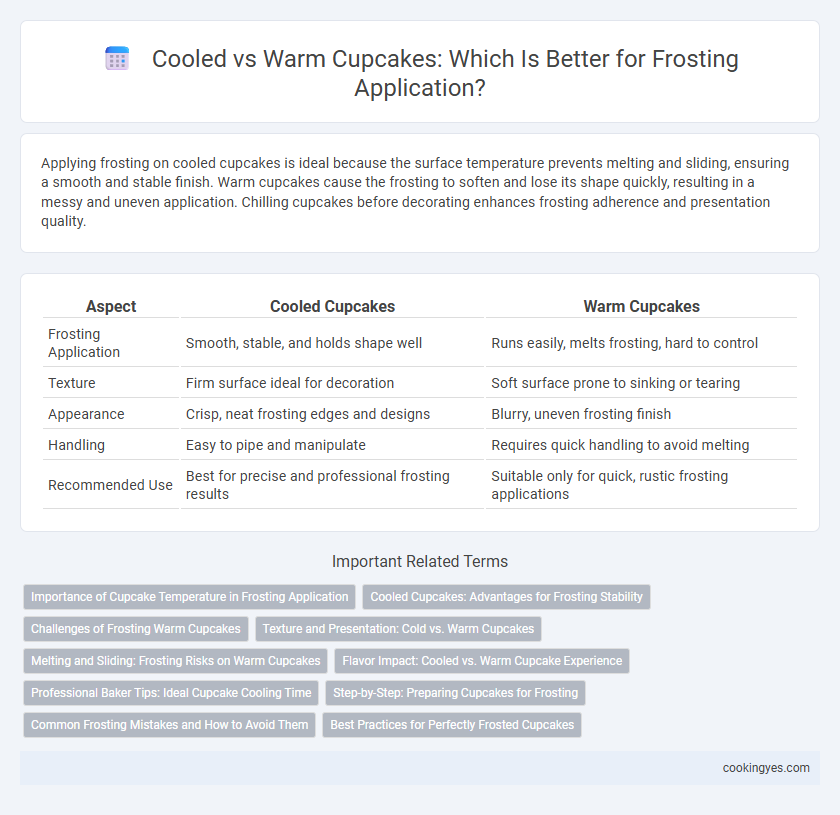Applying frosting on cooled cupcakes is ideal because the surface temperature prevents melting and sliding, ensuring a smooth and stable finish. Warm cupcakes cause the frosting to soften and lose its shape quickly, resulting in a messy and uneven application. Chilling cupcakes before decorating enhances frosting adherence and presentation quality.
Table of Comparison
| Aspect | Cooled Cupcakes | Warm Cupcakes |
|---|---|---|
| Frosting Application | Smooth, stable, and holds shape well | Runs easily, melts frosting, hard to control |
| Texture | Firm surface ideal for decoration | Soft surface prone to sinking or tearing |
| Appearance | Crisp, neat frosting edges and designs | Blurry, uneven frosting finish |
| Handling | Easy to pipe and manipulate | Requires quick handling to avoid melting |
| Recommended Use | Best for precise and professional frosting results | Suitable only for quick, rustic frosting applications |
Importance of Cupcake Temperature in Frosting Application
The temperature of cupcakes critically affects frosting adhesion and texture, with cooled cupcakes providing a stable surface that prevents melting and sliding of the frosting. Applying frosting on warm cupcakes often leads to uneven spread and a compromised structural integrity due to heat-induced softening. Optimal cupcake temperature ensures smooth frosting application, preserving both visual appeal and taste experience.
Cooled Cupcakes: Advantages for Frosting Stability
Cooled cupcakes provide a stable surface for frosting application, preventing melting and sliding that often occurs with warm cupcakes. The firm, cooled texture allows the frosting to maintain its shape and structure, resulting in cleaner, more professional-looking decorations. This stability enhances the overall presentation and prolongs the freshness of the cupcakes.
Challenges of Frosting Warm Cupcakes
Frosting warm cupcakes poses challenges such as melting and sliding off due to heat, which compromises the texture and appearance. The heat causes the frosting to lose its structure, making it difficult to achieve clean, decorative designs. Cooling cupcakes completely before applying frosting ensures a stable base, allowing for smooth, even application and better overall presentation.
Texture and Presentation: Cold vs. Warm Cupcakes
Applying frosting on cooled cupcakes ensures a smooth, stable texture as the frosting adheres well without melting, preserving intricate designs and vibrant colors. Warm cupcakes cause frosting to soften and slide, resulting in uneven texture and less precise presentation. For professional-quality appearance and optimal mouthfeel, cupcakes should be fully cooled before frosting.
Melting and Sliding: Frosting Risks on Warm Cupcakes
Applying frosting to warm cupcakes increases the risk of melting and sliding, as the heat causes the frosting to soften and lose its structure. Cooled cupcakes provide a stable surface, ensuring the frosting sets properly without dripping or losing shape. Properly cooled cupcakes help maintain the aesthetic and texture of delicate frosting designs.
Flavor Impact: Cooled vs. Warm Cupcake Experience
Applying frosting to cooled cupcakes preserves the delicate crumb structure and delivers a more balanced sweetness, enhancing the overall flavor experience. Warm cupcakes tend to cause frosting to melt and become runny, which can dilute the intended taste and texture of the topping. The contrast between the rich, creamy frosting and the light, airy cooled cupcake creates a more harmonious flavor profile than the warmer option.
Professional Baker Tips: Ideal Cupcake Cooling Time
Professional bakers recommend cooling cupcakes for at least 30 to 60 minutes before frosting to prevent melting and achieve a smooth application. Warm cupcakes cause frosting to slide or become runny, compromising the texture and appearance. Optimal cooling on wire racks ensures even air circulation, preserving cupcake moistness while stabilizing frosting adherence.
Step-by-Step: Preparing Cupcakes for Frosting
Preparing cupcakes for frosting requires allowing them to cool completely on a wire rack, typically for 30 to 60 minutes, to prevent melting the frosting. Warm cupcakes retain steam that causes frosting to slide off or become runny, compromising texture and appearance. For best results, ensure cupcakes reach room temperature before applying frosting to achieve smooth, stable decoration.
Common Frosting Mistakes and How to Avoid Them
Applying frosting to cooled cupcakes prevents melting and sliding, a common mistake when frosting warm cupcakes, which causes uneven texture and appearance. To avoid this, ensure cupcakes are fully cooled to room temperature before frosting application, preserving the frosting's structure and visual appeal. Additionally, using a crumb coat layer helps seal in crumbs, resulting in a smooth, professional finish.
Best Practices for Perfectly Frosted Cupcakes
Applying frosting to cooled cupcakes ensures better adherence and prevents the buttercream from melting, maintaining smooth, clean designs. Warm cupcakes cause frosting to slide or become runny, compromising texture and appearance. For perfect cupcakes, allow them to cool completely at room temperature before frosting to achieve consistent, visually appealing results.
Cooled Cupcakes vs Warm Cupcakes for Frosting Application Infographic

 cookingyes.com
cookingyes.com